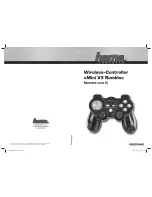
Broadcom Gigabit Ethernet Teaming Services
NetXtreme
User Guide
Broadcom
®
April 2017 • 2CS57XX-CDUM514-R
Page 119
Checksum Offload
Checksum Offload is a property of the Broadcom network adapters that allows the TCP/IP/UDP checksums for
send and receive traffic to be calculated by the adapter hardware rather than by the host CPU. In high-traffic
situations, this can allow a system to handle more connections more efficiently than if the host CPU were forced
to calculate the checksums. This property is inherently a hardware property and would not benefit from a
software-only implementation. An adapter that supports Checksum Offload advertises this capability to the
operating system so that the checksum does not need to be calculated in the protocol stack; because the
intermediate driver is located directly between the protocol layer and the miniport driver, the protocol layer is not
able to offload any checksums.
IEEE 802.1p QoS Tagging
The IEEE 802.1p standard includes a 3-bit field (supporting a maximum of 8 priority levels), which allows for
traffic prioritization. The BASP intermediate driver does not support IEEE 802.1p QoS tagging.
Large Send Offload
Large Send Offload (LSO) is a feature provided by Broadcom network adapters that prevents an upper level
protocol such as TCP from breaking a large data packet into a series of smaller packets with headers appended
to them. The protocol stack need only generate a single header for a data packet as large as 64 KB, and the
adapter hardware breaks the data buffer into appropriately-sized Ethernet frames with the correctly sequenced
header (based on the single header originally provided).
Jumbo Frames
The BASP intermediate driver supports jumbo frames, provided that all of the physical adapters in the team also
support jumbo frames and the same size is set on all adapters in the team.
IEEE 802.1Q VLANs
The IEEE 802.3ac standard defines frame format extensions to support Virtual Bridged Local Area Network
tagging on Ethernet networks as specified in the IEEE 802.1Q specification. The VLAN protocol permits
insertion of a tag into an Ethernet frame to identify the VLAN to which a frame belongs. If present, the 4-byte
VLAN tag is inserted into the Ethernet frame between the source MAC address and the length/type field. The
first 2-bytes of the VLAN tag consist of the IEEE 802.1Q tag type, whereas the second 2 bytes include a user
priority field and the VLAN identifier (VID). Virtual LANs (VLANs) allow the user to split the physical LAN into
logical subparts. Each defined VLAN behaves as its own separate network, with its traffic and broadcasts
isolated from the others, thus increasing bandwidth efficiency within each logical group. VLANs also enable the
administrator to enforce appropriate security and quality of service (QoS) policies. The BASP supports the
creation of 64 VLANs per team or adapter: 63 tagged and 1 untagged. The operating system and system
resources, however, limit the actual number of VLANs. VLAN support is provided according to IEEE 802.1q and
is supported in a teaming environment as well as on a single adapter. Note that VLANs are supported only with
homogeneous teaming and not in a multivendor teaming environment. The BASP intermediate driver supports
VLAN tagging. One or more VLANs may be bound to a single instance of the intermediate driver.
Summary of Contents for NetXtreme BCM57 Series
Page 1: ...Broadcom NetXtreme BCM57XX User Guide Last revised April 2017 2CS57XX CDUM514 R...
Page 16: ...Functionality and Features NetXtreme User Guide Broadcom April 2017 2CS57XX CDUM514 R Page 16...
Page 169: ...Regulatory Information NetXtreme User Guide Broadcom April 2017 2CS57XX CDUM514 R Page 169...
Page 170: ...Regulatory Information NetXtreme User Guide Broadcom April 2017 2CS57XX CDUM514 R Page 170...
Page 171: ...Regulatory Information NetXtreme User Guide Broadcom April 2017 2CS57XX CDUM514 R Page 171...
















































